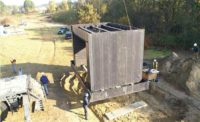
BASF Corp., Cleveland, recently previewed a new liquid admixture it claims eliminates the need for air-entrained concrete, a material used in regions exposed to freeze-thaw cycles.
Touted as breakthrough technology, the still-unnamed chemical product has been in development for eight years and will be available in 2015. The additive uses millions of microspheres coated with tough but flexible polymeric shells, "similar to very tiny tennis balls," explains Mark Bury, BASF product manager.
The microsphere voids provide internal cushioning during freeze-thaw cycles for greater durability, says Bury. Microspheres are unlike air bubbles that can be easily popped or destroyed, and the 1%-by-volume admixture is up to 30% stronger than air-entrained concrete, which uses between 4% to 7% air.
According to BASF, concrete strength diminishes by 3% to 5% for every 1% of air added. The formula is less susceptible to weather, material and construction variables, which can add "hidden costs and quality-control issues," Bury adds.
Dry microspheres have existed since the 1970s, with some still in use throughout Europe; widespread use has been curtailed by handling problems and delivery costs. "Dry microspheres are difficult to manage because they are so small and light—they quickly become airborne," Bury says. "They're shipped in large, extremely light bags." In contrast, BASF's microsphere product is shipped as a slurry.
Having tested the patent-pending material up to 10,000 psi, BASF is planning pilot road projects in Minnesota, Virginia and Ohio and seeking the approval of standards boards.



Post a comment to this article
Report Abusive Comment